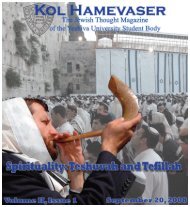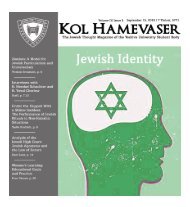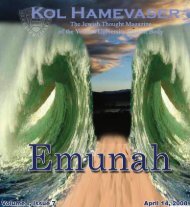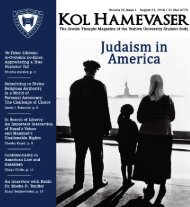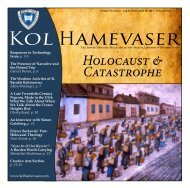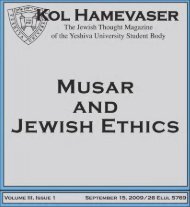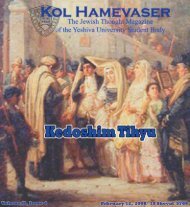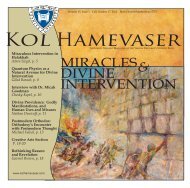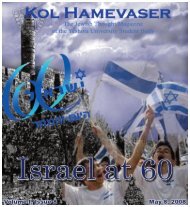Create successful ePaper yourself
Turn your PDF publications into a flip-book with our unique Google optimized e-Paper software.
<strong>Halakhah</strong> <strong>and</strong> <strong>Minhag</strong><br />
The Synthesis of Heritage <strong>and</strong> Personal Innovation i<br />
BY: Ariel Pinn<br />
The student of Torah, when reflecting<br />
upon its depth, recognizes that it must<br />
contain aspects not yet articulated by<br />
any of his predecessors. ii Which guiding principles<br />
should he use to determine if his unique<br />
insights subscribe to amittah shel Torah (the<br />
truth of the Torah)? The Nefesh ha-Hayyim<br />
(whose fourth section is dedicated to describing<br />
the unparalleled exaltedness of Torah <strong>and</strong><br />
its role of upholding all of Creation) magnificently<br />
describes the merit of one who reaches<br />
this priceless goal:<br />
“[Concerning] true hiddushim (novel<br />
ideas) in Torah which are devised by man,<br />
there is no value to the magnitude of their<br />
awesome wondrousness <strong>and</strong> their effects<br />
in Heaven. For each <strong>and</strong> every individual<br />
word, which is devised in the mouth of<br />
man, the Holy One Blessed be He kisses<br />
it <strong>and</strong> crowns it, <strong>and</strong> builds from it a new<br />
world of its own.” iii<br />
What is required to develop a hiddush that<br />
will achieve such awe-inspiring heights?<br />
Pirkei Avot, the fundamental representation<br />
of Jewish Hashkafah (outlook), specifically<br />
places the description of Torah<br />
inheritance as its inaugural statement: “Moshe<br />
received the Torah from Sinai, u-mesarah iv to<br />
Yehoshua, <strong>and</strong> Yehoshua to the Elders, etc.” v<br />
This was the founding step of the institution of<br />
semikhah, whereby Torah is passed from sage<br />
to student. While Moshe Rabbeinu disseminated<br />
the sacred words of the Torah to<br />
Yehoshua, he also transmitted his personal<br />
guidance to the future leader of the nation. In<br />
Jewish law, a musmakh (one who received<br />
semikhah) is not simply one who studied its<br />
laws; he must be a part of that transmission of<br />
Masorah (heritage) which began with Moshe<br />
Rabbeinu passing the tradition on to Yehoshua.<br />
This system ensures that each student has the<br />
tutelage of a member of the Masorah, <strong>and</strong> is<br />
provided with the proper shimmush talmidei<br />
hakhamim (live experience around talmidei<br />
hakhamim) – the added personal shimmush<br />
which cannot be learned from books, but rather<br />
is an all-encompassing heritage from Har<br />
Sinai.<br />
Is there any room in this framework, one<br />
based on reverence for traditions of the past,<br />
for novel ideas? vi This question of permissibility<br />
to engage in hiddush was once presented to<br />
the Hazon Ish, zts”l:<br />
“How can it be tenable to invent new<br />
thoughts in Torah after it was given in its<br />
entirety at Har Sinai? [ Presumably,] the<br />
creator of new ideas is merely revealing<br />
that which was previously hidden in the<br />
words? The Hazon Ish replied: All the<br />
laws of nature have been set in the world<br />
from the time it was created. However,<br />
Torah contains the thought of Hashem<br />
Who is above Creation, <strong>and</strong> [therefore]<br />
any explanation in the writings [of Torah]<br />
which has not yet been revealed has not<br />
yet reached the stage of ‘Creation;’ rather,<br />
its existence is [solely] in the knowledge<br />
of the One Above. Only after a person<br />
merits <strong>and</strong> perceives the intention of the<br />
Giver of the Torah in some explanation –<br />
only starting from that moment is the hiddush<br />
materialized into the reality of the<br />
created world, [<strong>and</strong> is thus] accordingly<br />
called a new idea.” vii<br />
His words show that there surely is a concept<br />
in Judaism of man-driven hiddush resulting<br />
from thorough engagement with the Torah,<br />
as is well known in every beit midrash. Indeed,<br />
we see this manifest when each year a multi-<br />
“In Jewish law, a musmakh is not simply one<br />
who studied its laws; he must be a part of that<br />
transmission of Masorah which began<br />
with Moshe Rabbeinu passing the<br />
tradition on to Yehoshua.”<br />
tude of new works can be found on the shelves<br />
of Judaica stores.<br />
Ha-Gaon ha-Rav Yosef Dov Ha-Levi<br />
Soloveitchik, zts”l (henceforth “the Rav”), illustrated<br />
this idea by quoting the hesped (eulogy)<br />
which Ha-Gaon ha-Rav Velvel<br />
Soloveitchik, zts”l (his uncle), delivered for<br />
Ha-Gaon ha-Rav Hayyim Soloveitchik, zts”l<br />
(the Rav’s gr<strong>and</strong>father). There, he described<br />
that in R. Hayyim’s exploration of the vast<br />
depths of Torah, “he had no need for a library<br />
[of sefarim]; his bookshelf contained only the<br />
fundamental sources <strong>and</strong> no more.” viii This<br />
highlighted his reliance on the core Jewish<br />
sources alone to develop his novel <strong>and</strong> creative<br />
interpretations. R. Shalom Carmy relates that<br />
the Rav himself shared a similar approach to<br />
talmud Torah (study of Torah). ix Additionally,<br />
many decisions have been made in Judaism by<br />
talmidei hakhamim about new events <strong>and</strong> issues<br />
which arose in their generations. For example,<br />
the crisis of Jewish assimilation in<br />
Europe prompted the Hafets Hayyim, zts”l, to<br />
approve Sarah Schenirer’s righteous request to<br />
start the Bais Yaakov movement. Even though<br />
the movement diverged from the traditional<br />
model of female education that occurred within<br />
the home, the Hafets Hayyim realized that<br />
based on the prevailing conditions, something<br />
had to be done.<br />
Similarly, Ha-Gaon ha-Rav Moshe Fein-<br />
stein, zts”l, permitted women to go to the<br />
mikveh with earplugs, a ruling which went<br />
against prior opinions on the subject. x Subsequently,<br />
the sho’el questioned whether one can<br />
follow this decision, considering that it was<br />
against the conclusions of previous generations.<br />
R. Moshe contended that it is irresponsible<br />
to decide a law based solely on the works<br />
of earlier generations, as there are constantly<br />
new cases that arise. The Torah is to be implemented<br />
in each generation in accordance with<br />
its arbiters of <strong>Halakhah</strong>. xi It is certainly permissible<br />
for a talmid hakham to state an opinion<br />
contradictory to previous rulings of Aharonim<br />
<strong>and</strong> at times even the Rishonim. xii This must be<br />
done with “an in-depth examination of the Talmud<br />
<strong>and</strong> the classic literature, utilizing sharp<br />
intellect <strong>and</strong> accurate proofs, even if the conclusions<br />
are new […] as is stated: ‘The only<br />
consideration for the judge is that which his<br />
eyes see.’ xiii ” One caveat is that his words may<br />
not conflict with those of the globally accepted<br />
authorities on Shulhan Arukh. Additionally,<br />
this should only be exercised in great need,<br />
similar to the aforementioned case which<br />
would otherwise result in the termination of a<br />
marriage. xiv<br />
The Rav, in Halakhic Man, emphatically<br />
addresses the importance of hiddush: xv “Halakhic<br />
Man is a spontaneous, creative type. He<br />
is not particularly submissive <strong>and</strong> retiring, <strong>and</strong><br />
is not meek when it is a matter of maintaining<br />
his own views.” xvi However, in the context of<br />
his passion for hiddush, he adds a critical stipulation<br />
to the halakhic man’s outlook: “He recognizes<br />
no authority other than the authority of<br />
the intellect (obviously, in accordance with the<br />
principles of tradition).” xvii The Rav then continues<br />
to describe how hiddush is placed on a<br />
pedestal in Judaism. He stresses that hiddush<br />
is not merely permissible – it is imperative:<br />
“Halakhic man received the Torah from<br />
Sinai not as a simple recipient but as a creator<br />
of worlds, as a partner with the<br />
Almighty in the act of creation. The<br />
power of creative interpretation (ḥiddush)<br />
is the very foundation of the received tradition<br />
[…] All new, creative insights that<br />
a bright student will glean are an integral<br />
part of the Oral Law xvi […] The essence<br />
of the Torah is intellectual creativity.” xi<br />
However, while the implementation of<br />
creativity is essential, there is a limitation on<br />
the context within which one can exercise it.<br />
As the Rav cautions in Halakhic Mind, “If an<br />
objective compass be lacking, the final port of<br />
l<strong>and</strong>ing is uncertain.” xx There is a distinction<br />
between suggesting a hiddush <strong>and</strong> steering towards<br />
shinnui (change), which is a departure<br />
from the Masorah. xxi The Rav strongly contests<br />
an approach that embraces shinnuyim:<br />
“The ab<strong>and</strong>onment of certain traditional concepts<br />
in favor of more modern ones is nothing<br />
but sheer whimsicality if not foolhardy iconoclasm.”<br />
xxii<br />
Historically, this issue came to a head<br />
when a certain rabbi decided to overstep this<br />
Volume III, Issue 7 www.kolhamevaser.com<br />
boundary, moving from hiddush to shinnui,<br />
<strong>and</strong> the Rav was subsequently forced to address<br />
it in a derashah (sermon) at the Rabbinical<br />
Council of America Convention. xxiii His<br />
opening statements illustrate the gravity of his<br />
words: “What I am going to say, I want you to<br />
underst<strong>and</strong>, is my credo about Torah <strong>and</strong> about<br />
the way Torah should be taught <strong>and</strong> Torah<br />
should be studied.” xxiv He then firmly establishes<br />
the role of intellect in talmud Torah:<br />
“[…] The study of Torah has never been<br />
for me dry formal intellectual performance,<br />
no matter how important a role the<br />
intellect plays in limud hatorah […] talmud<br />
torah is more than intellectual performance.<br />
It is a total, all-encompassing<br />
<strong>and</strong> all-embracing involvement – mind<br />
<strong>and</strong> heart, will <strong>and</strong> feeling, the center of<br />
the human personality - emotional man,<br />
logical man, volunteristic man – all of<br />
them are involved in the study of Torah.<br />
Talmud torah is basically for me an ecstatic<br />
experience, in which one meets Gd<br />
[…] So must every Jew who engages in<br />
talmud torah st<strong>and</strong> before G-d with fear,<br />
awe, <strong>and</strong> tremor.” xxv<br />
Perforce of this perspective, the true student<br />
of Torah will display humility, since he is<br />
engaged in the awesome words of Hashem. xxvi<br />
“When a finite being meets the Infinite, the<br />
Maker of the world, this meeting must precipitate<br />
a mood of humility.” This humility effects<br />
a surrender to the Almighty in two areas. There<br />
is a surrender of “everyday logic” in deference<br />
to the reasoning of the Masorah, <strong>and</strong> also a<br />
surrender of the will of a person to the dictates<br />
of the Masorah. He must have a complete kabbalat<br />
ol malkhut Shamayim (acceptance of the<br />
yoke of Heaven) – <strong>and</strong> a yoke can be uncomfortable<br />
at times. xxvii<br />
From a background of talmud Torah that<br />
is rooted in complete kabbalat ol malkhut<br />
Shamayim, the Rav continues by outlining four<br />
areas which emerge from such a relationship:<br />
“Firstly, we must pursue the truth through<br />
singular halachic Torah-thinking <strong>and</strong><br />
Torah-underst<strong>and</strong>ing: from within, in accord<br />
with the methodology given to<br />
Moshe <strong>and</strong> passed on from generation to<br />
generation. The truth can be discovered<br />
only through joining the ranks of the<br />
Chachmei ha-Masorah [the ones knowledgeable<br />
in the Masorah]. To say, ‘I have<br />
discovered something the Rashba didn’t<br />
know, the Ketzos didn’t know, the Go’on<br />
of Vilna had no knowledge of; I have discovered<br />
an approach to the interpretation<br />
of Torah which is completely new,’ is<br />
ridiculous. xxviii<br />
For one to be part of the Hakhmei ha-Masorah,<br />
his statements must be made from<br />
within the framework of that Masorah; to say<br />
a hiddush based on the surrounding influences<br />
is what leads to assimilation. Secondly, instead<br />
of suffering an inferiority complex due to a<br />
prevailing societal motto that runs against the<br />
Masorah, one should feel a pride in that very<br />
19



